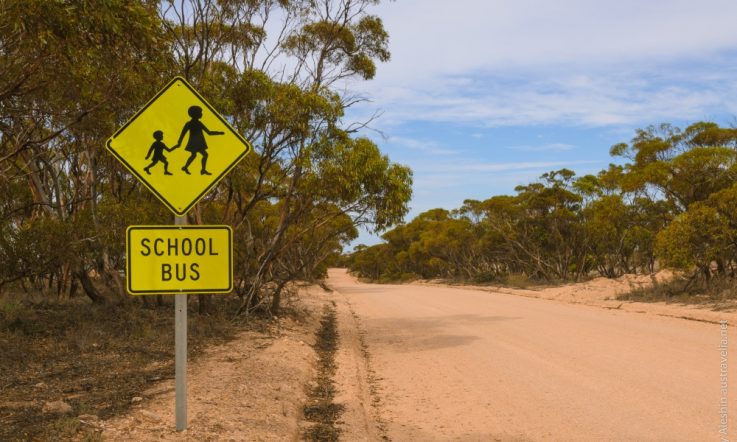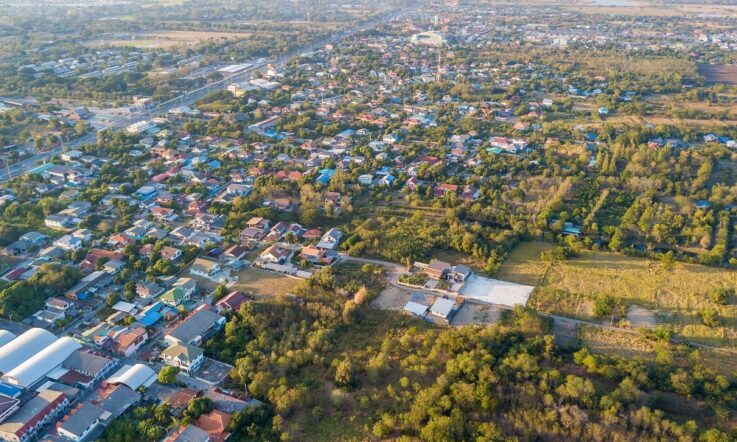This podcast from Teacher is supported by TruSens. Cleaner air everywhere. Experience the difference of cleaner air at home and at work with TruSens air purifiers.
Thanks for downloading this podcast from Teacher magazine. I’m Zoe Kaskamanidis.
What makes leadership impactful in regional, rural and remote schools? And how can schools start to establish a robust framework for creating positive impact in the long term?
In this episode of the Research Files, I’m joined by Scott Eacott, Professor of Education in the School of Education, and Deputy Director of the Gonski Institute for Education at the University of New South Wales in Sydney.
Throughout his career, Scott has researched how education can be best organised to ensure equitable and inclusive education for all. Today, we’ll be unpacking some of the concepts covered in his recent research on leadership in regional, rural and remote schools.
Zoe Kaskamanidis: You'll notice from the audio that this episode is a little different. We weren't able to record a live conversation with Scott but thanks to technology he was able to supply the answers to my questions. To begin, here’s Scott telling us a little bit about the research and what first led him to look at leadership in remote settings
Scott Eacott: I’m fascinated by, and driven to engage with the enduring problem of how best to organise schooling to ensure equitable and inclusive education for all. This ambitious research program aims to move beyond individual discipline-based ways of understanding education and its impact, to working at the intersection of education, sociology, demography, economics, planning, among others. To leverage cutting edge and analytical techniques to not just inform policy decisions, but to explicitly contribute to redesigning the provision of education, to deliver equitable and inclusive education at scale.
In perhaps better terms, I’m interested in how we organise education, the resulting outcomes we get, and how things could be different. The stimulus for my research was working in schools as a teacher and a leader, and seeing how diverse contextual factors led to different experiences and outcomes for staff, students and communities. This was made particularly apparent for me while I was working at Lord Howe Island Central School, but it was equally true in other schools I worked at.
While there are many places that attract attention in education, it is arguably those at the margins where the most interesting work is taking place. In fact, the centres of education have arguably changed very little over time. At the margins, everything is amplified: inequities, funding, school-community relations, the social, the historical, the environmental issues. This is what’s attracted me to studying schools on the margins – of which regional, rural and remote schools are definitely that case.
ZK: Scott was lead author of a paper recently released by the Commonwealth Department of Education, Skills and Employment (it's called High-Impact School Leadership: regional, rural and remote schools and I'll add the reference and link in the transcript of this podcast). It identifies four key attributes of high-impact leadership in these schools: an innovation imperative; collective responsibility; a focus on teaching and learning; and visibility in and commitment to the community. Here's Scott explaining a bit more about the research project, each of the four attributes, and what they might look like in practice for schools.
SE: There is plenty of data to show that geography matters for the outcomes of schooling. The further a school is located from a major city, the lower the levels of performance in standardised tests and exit examinations. While we can argue about the metronormativity of tests and examinations, we simply cannot continue to accept these inequities.
This project – which was commissioned by the Commonwealth Department of Education, Skills and Employment – sought to investigate high-impact leadership in regional, rural and remote schools. We worked with major principals’ associations to identify schools that exhibited high impact in its most broader sense. Not limited to student test scores, we sought schools that had clarity of purpose, coherence in their activities, and were actually telling the story, telling their own stories of success – schools that not only talked the talk, but walked the walk.
We compiled a list of potential schools, and then either did case studies – pre-COVID – or interviews with school leaders, during the pandemic, that led us to develop a framework based on four attributes.
The innovation imperative – the first of the four attributes – is focused primarily on this idea that the status-quo is simply not good enough. Now, this does not give people permission to go and innovate, or experiment I should say, on some of our most vulnerable communities, but it does give them permission to think differently about how we support students, staff and communities. It’s also about thinking long term – thinking multi-agency, whole-of-government approaches to how we actually develop communities, not just schools. And this innovation imperative also gets us to think about – funding is just not enough; throwing more funding at these schools are not going to solve their problems. What is it that we actually need to do differently to improve these outcomes for everyone? And very much core to this activity, is this notion of – and this is the second attribute of our framework – collective responsibility.
You’ll notice that when we talk about the project it’s always talk about high-impact leadership, not high-impact leaders. This idea of collective responsibility, this idea of high impact from our study is more than the principal. It’s about, what are schools doing to have an impact in their community? That means it’s locally-grounded. How are they actually reaching out and having an impact on staff, students, families and the broader community? And in doing so, it’s not about competition with the school down the road, but actually collaboration – thinking together, and collaborating for the good of communities, not just competing for enrolments all the time.
But of course, as with everything in schooling, the core business is teaching and learning and therefore our third attribute is around a focus on teaching and learning. If we want to improve the outcomes, if we want to have impact, we have to focus on that core business of teaching and learning and we need to get things out of the way of our staff so that they can focus most of their time on things that will have the greatest impact on teaching and learning in the school. And that comes down to sometimes saying ‘no’ to things.
High-impact leadership is when the whole school – leaders, everyone on staff – is involved in professional learning. This is how coherence is achieved in activities – when everyone is on this sort of same principal journey of improving teaching and learning.
And of course, impact (given the nature of the project) is about more than standardised tests. Now that doesn’t mean that we discard the basics and very core importance of literacy and numeracy – they remain fundamental. But it’s also about, what is the impact we’re actually having on these students and these families? What are we actually doing in the community, as a result of working in this school?
And of course part of this, we all know that there’s great staff turnover, and these shifting populations of educators coming in and out of lots of these regional, rural and remote communities. The fourth attribute – and an incredibly important and powerful one – is about visibility in and commitment to community.
Trust is built when the community see educators in the community, when they see things that demonstrate that the educators are there working and committed to the long-term future and sustainability of communities. It’s also about making the curriculum authentic. Connecting that curriculum to where you are, engaging with the events and the natural wonders that surround the school, and bringing the curriculum to life in context.
And of course, fundamental to this high-impact leadership is that we have educators who are not just seeing these regional, rural and remote schools as a stepping stone on their career path, but actually a place to make an impact themselves, and actually contribute to something – a much bigger picture.
Now, taken together, we believe that these four attributes is a really productive way of thinking about how best to prepare and support school leaders and educators working in regional, rural and remote schools. It involves a unique mixture of learning for leadership and understanding some of those complex dynamics within and beyond the school, and learning how to lead the school. And this is what we think makes an incredibly generative framework, and something that should be of great use to educators and systems.
We’ll hear more from Scott after this quick message from our sponsor.
You’re listening to a podcast from Teacher magazine, supported by TruSens. Improve your indoor air quality today with TruSens Z-3000 Air Purifier. Featuring a unique SensorPod to detect pollutants throughout the room, not just by the purifier. Also featuring a 360° Dupont True HEPA filter to capture airborne viruses, allergens & certain VOC gases from all directions, while the built in UV-C light kills germs and bacteria trapped in the filter. Trust TruSens Z-3000 to provide cleaner air indoors.
ZK: Welcome back. Our guest today is Scott Eacott. Thinking relationally is a big part of the research he’s been doing. I was interested to find out more about this approach. Here’s Scott telling us a bit about how it was applied in his recent study.
SE: Most debates in education are based on alternative versions on the purpose or purposes of schooling and how they play out. In the absence of having clarity in our own purpose, others will impose their version and make judgements based on that. Thinking relationally seeks to make these potential conflicts visible and support educators in navigating them and moving forward.
So let me just give you a brief example. As I noted, many debates in education stem from divergent perspectives on the purpose of education. So, an initial step is articulating the underlying assumptions we hold regarding the purpose of education – and that includes not just the desired outcomes, but also the role of teachers, curriculum, assessment, students and so on.
If there is diversity on the purpose or purposes of education, then you need to be able to relate your own purpose to those held by others. And this is more than just acknowledging there are lots of ways of doing things, it’s about actually understanding the distinctions between your position and that of others. What makes your position different? This is fundamental to being able to justify decisions you make regarding actions taken and not taken when you are faced with critique. Without clarity of purpose there is little ground to actually defend the decisions that you make.
With clarity comes coherence. If you say you are working towards something, your actions should be directed to delivering on that. Your purpose should be enacted in the classroom, on the playground, in staff meetings, and in general interactions. It is this coherence that builds trust and integrity in what you do. Importantly, because it is built on clarity of purpose, it’s no longer about right or wrong approaches, and instead, it’s about coherence.
Put simply, do the activities of the school support the purpose? Can it be defended if critiqued? This is not to say that schools are perfect or that this process is perfect, but they’re all working together towards purpose.
And then finally, if you have clarity of purpose, and coherence of activities, you get the opportunity to tell the narrative of your school. It’s not about an imposed version of what should be done in a school, it’s about what you actually do, what it looks like in practice, and what it is that you deliver on.
For the purpose of this particular study on high-impact leaders, we asked principals about their purpose of education, how that related to others (including why they were chosen by their peers as high-impact leaders), how it plays out in practice in their particular school, and what is the story of their school.
This enabled us to study a range of schools from across all sectors and states and territories, without imposing a single measure of what is high impact. If we really believe that context matters, then adopting an approach that allows for contextual variance, without imposing a single narrative of what high impact looks like, is really important and thinking about it relationally enabled us to do that.
In addition, thinking relationally enabled us to actually co-design the sampling with the profession, working with principals’ associations to actually identify people. It enabled us to build a framework from the data that we actually generated with school leaders. It was not something that we already had in mind and went out and found people who met that criteria, we actually built it from the ground with the profession. This, we believe, makes our framework of great value for schools and systems going forward.
ZK: From Scott’s comments, it sounds like generating a framework with school leaders and in recognition of schools’ diversity of purpose, is a more sustainable framework for a broader variety of schools to work to, rather than, say, a one-size fits all approach.
And while we were on the topic of purpose, here’s an excerpt from the study: ‘Rather than thinking of initiatives in two- or three-year strategic planning cycles, there is a need to think through what they look like for a generation (six to seven years) of students. To achieve this, a school must have clarity concerning its purpose. Not fancy slogans and mottos, but a clearly articulate purpose and coherence in activities. This provides a reference point for decision making. If an activity is not explicitly supporting the school’s purpose, then there are grounds for not doing it.’
In terms of this idea of purpose, I asked Scott how regional, rural and remote schools can come to a dedicated purpose that remains relevant and suitable for staff, students and community in the long term.
SE: A school’s purpose is never set in stone – or should not be. It’s a dynamic statement that is constantly unfolding in relation to other activities. Changes in the community, in the general conditions, not to mention students, all need constant adaption. So, it’s actually about moving beyond the school gates. It’s about blurring those boundaries between schools and communities, while at the same time, ensuring the acknowledgement of expertise of the educators that work in the school. It is about making clear the purpose of education, and bringing coherence to activities; bringing to life that purpose in the specific contexts of the school. And ‘contexts’ (plural) is intentional there – it’s about understanding the various experiences and expectations of schooling, and how to make them work together in the contemporary condition.
There are many challenges on that – based on history, changes in staffing, shifting dynamics and demographics, among others – but keeping that process open, and constantly relating what is done with what is expected, and being able to justify decisions in the face of criticism. What can be defended remains, what cannot be defended gets dropped. People might not always agree with decisions made but if there is a clearly articulated purpose, they should respect it.
And if that does not work, we must be able to acknowledge and accept that as well. Relevance and suitability is enhanced if there is a perception of visibility and commitment to the community. If communities trust that you are working for their long-term outcomes, not just for next line in your CV, that builds support, especially when those actions can be justified against a shared purpose.
ZK: On that, and also coming back now to the attribute of innovation, I really liked the nuance identified in the report when it comes to longer-term thinking, and this question of how funding cycles can sometimes limit longer-term goals. Here’s Scott talking about the first steps can school leaders take to make these structural shifts, independent of funding reliance.
SE: Australia has a complex education architecture. The Commonwealth has the funds, the state and territory governments have constitutional oversight, election cycles rarely align, yet they’re relatively short as well. This is a major impediment to innovative thinking, as it leads to constant changes in regulations, policies and procedures.
Education, sometimes of its own doing, is frequently charged with solving many of society’s ills. On its own, education cannot solve intergenerational social, economic or health inequities; that requires a whole-of-government approach, physical infrastructure, such as reliable broadband, access to services, all impact on what education can and cannot achieve.
For those schools on the margins, attracting the level of attention to gain the funding required to address these issues is unlikely. That unfortunately is a reality for many of our regional, rural and remote communities.
For school leadership, a first step is making education about something bigger – a big agenda of hope. Making the purpose or purposes of education come to life for individuals and the collective. But this is arguably the easiest step. It is the second and so on steps where it gets really tough. Those steps are about bringing that purpose into being. What do we need to have in place? What is available in schools? In communities? In the system? Outside the system? What do we need and how do we get it? Being relentless in getting the things that your staff and students need to thrive.
The parallel activity – and not an easy one for many – is knowing what to let go of. You simply cannot say ‘yes’ to every initiative. That is why purpose is such a powerful touchstone. If it is not helping to work toward your purpose, then do not do it. And the same goes for existing practices. Sometimes, letting go of something is needed to move the school forward. Educators are not good at saying ‘no’; especially if they believe that someone is missing out on an experience in doing so. But sometimes, saying ‘no’ enables you to do more of the stuff that’s needed for the staff, students and the community who you serve.
ZK: I’m sure many of you listening can relate to that point, in that it can be sometimes difficult to say ‘no’, but it’s often still a matter of ‘these are the resources we have – where can they best be directed?’ It sounds like reflecting on purpose is a great tool in thinking through these questions.
To end today’s episode, here’s Scott with one final reflection.
SE: There are many educators throughout the country working tirelessly to improve the outcomes for students and communities. While we often spend our time debating individual teaching techniques and approaches, we’re attacking different sections of the education community.
There’s a need to take a step back and ask the big question – how do we organise education to enable staff to do their best work? What do we need to get out of their way? What do we need to make available for them? What supports and infrastructure do we need around schools to ensure equitable and inclusive outcomes for all?
This is a challenging task. It’s a big question. It requires getting our hands dirty. It might force us to deal with and confront some really difficult truths. But anything worth something takes work. And it’s engaging in this work with and for educators and students that keeps me going.
Thanks for the opportunity to share today.
That’s all for this episode of The Research Files, thanks for listening. If you haven’t already, be sure to subscribe to our podcast channel on Spotify, Apple podcasts, SoundCloud, or wherever you get your podcasts from, so you can keep up to date with our latest episodes. If you want to keep listening now, you can access the 200+ episodes already in our archive. And, while you’re there, we’d love it if you could rate and review us.
You've been listening to podcast from Teacher, supported by TruSens. Cleaner air everywhere. Experience the difference of cleaner air at home and at work with TruSens air purifiers.
References
Eacott, Niesche, R., Heffernan, A., Loughland, T., Gobby, B., & Durksen, T. (2021). High-impact school leadership: regional, rural and remote schools. Commonwealth Department of Education, Skills and Employment, Australia. http://handle.unsw.edu.au/1959.4/unsworks_75297
In this podcast, Scott Eacott speaks about the importance of visibility and commitment to community, and of working toward shared outcomes. In what ways does your school engage with the broader community? How do you work with community to achieve shared outcomes?
As a principal, reflect on what the purpose of your school is, and how that purpose drives the decisions you make as a leader. How can your school’s purpose inform the activities and initiatives you pursue or leave behind?



